A guide to the French source material
The French dataset is, in fact, a combination of two quite different datasets. The first dataset is derived from the long-form insurance registers of the Royal Insurance Chamber (1668-86), while the second dataset is derived from the short-form alphabetical register of the Royal Insurance Company (1686-c. 1700). A full contextualisation of the institutions can be found in L. Wade, Privilege, Economy and State in Old Regime France: Marine Insurance, War and the Atlantic Empire under Louis XIV (Woodbridge: Boydell Press, 2023). This can be accessed here for free; the appendices, which compile data from the datasets, can be found here. Users who choose to engage extensively with the datasets without first understanding the peculiarities of the institutions and the data do so at their own peril. The same holds true for users who try to make comparisons across the two datasets without acknowledging their profoundly different foundations.
The currency used throughout the dataset is the livre tournois. This was the money of account in wide use across France in the reign of Louis XIV.
Consulting the records
There are three ways to consult the records. The best choice for the novice user is the Map of Ports function, available by clicking “Maps” and then “Map of Ports” on the navigation bar. Using Google Maps functionality, the user can visualise the Chamber’s insurance policies in 1668. By inputting the year 1668 and selecting “Royaume de France” as the source material, the user can see every port or place touched in the voyages underwritten in the Chamber that year.
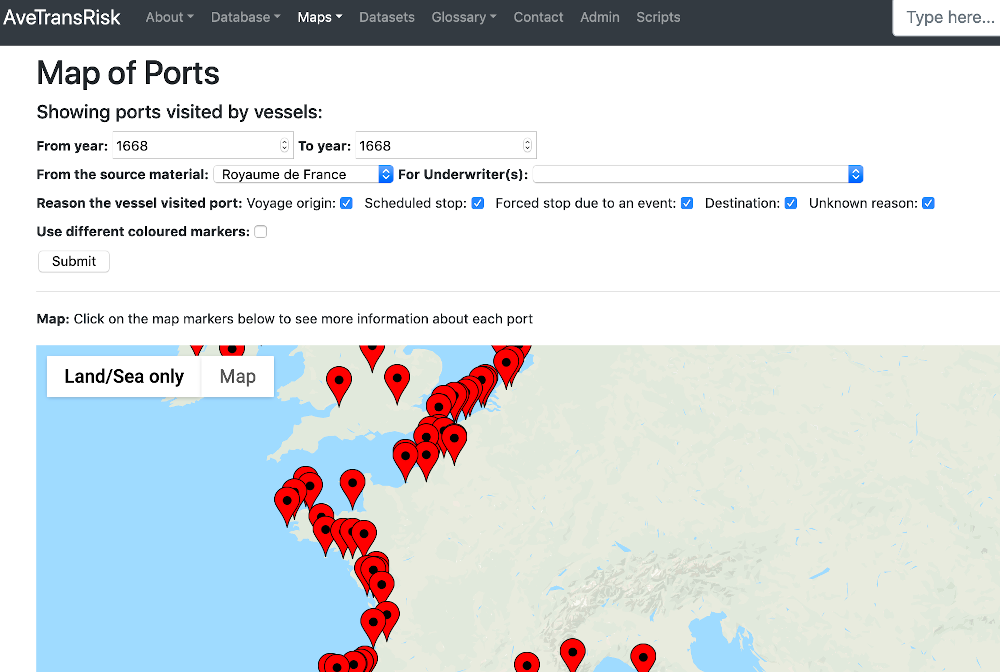
The 'Map of Ports' page - click for a larger version
By clicking on the markers, the user can a) see the name of the port/place and how often it was touched in 1668, and/or b) click “See more” to see all the insurance policies involving that port/place.

a) Clicking on a marker - click for a larger version
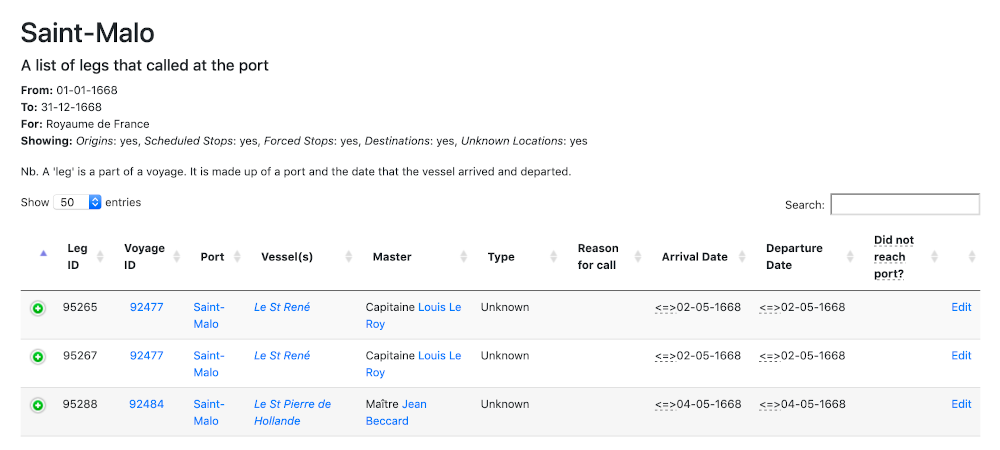
b) Clicking 'See more' - click for a larger version
From there, users can consult specific records at their pleasure. Below the map is the “Show” box; users can click “Circles that display the number of times the port was visited during the chosen time period” to perform this function if they wish.
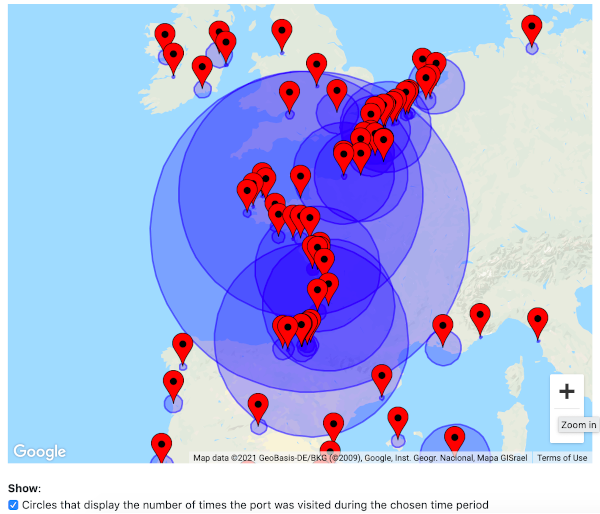
Clicking the 'Show Circles' checkbox - click for a larger version
In the case of the Chamber, the user can also choose to study the portfolio of individual Underwriters, through selecting "Database" and then "Underwriters" on the navigation bar. This brings up a page listing every underwriting entity (individual, partnership or company) who underwrote in the Chamber.
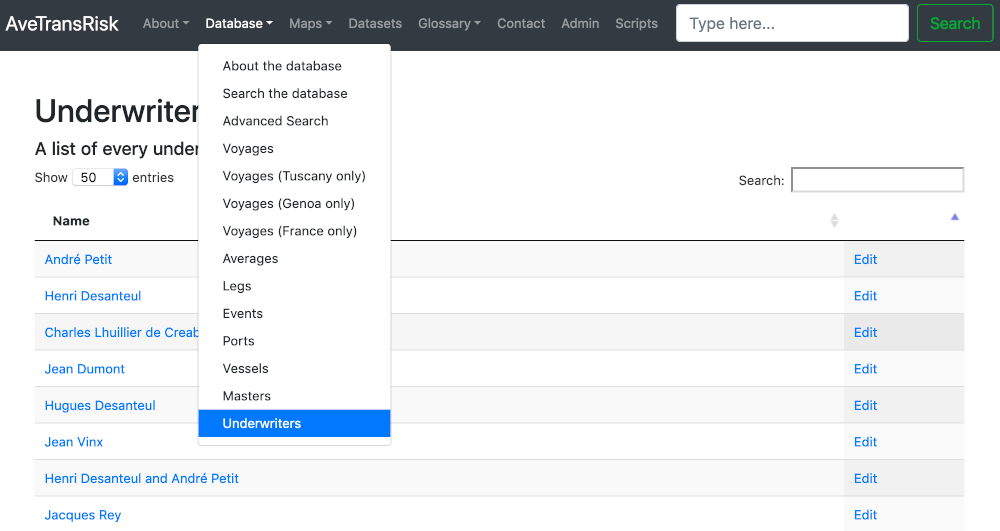
The List of Underwriters - click for a larger version
By clicking on the name of an underwriting entity, the user can view the entire underwriting portfolio of the entity for the year and access individual voyages as they wish.
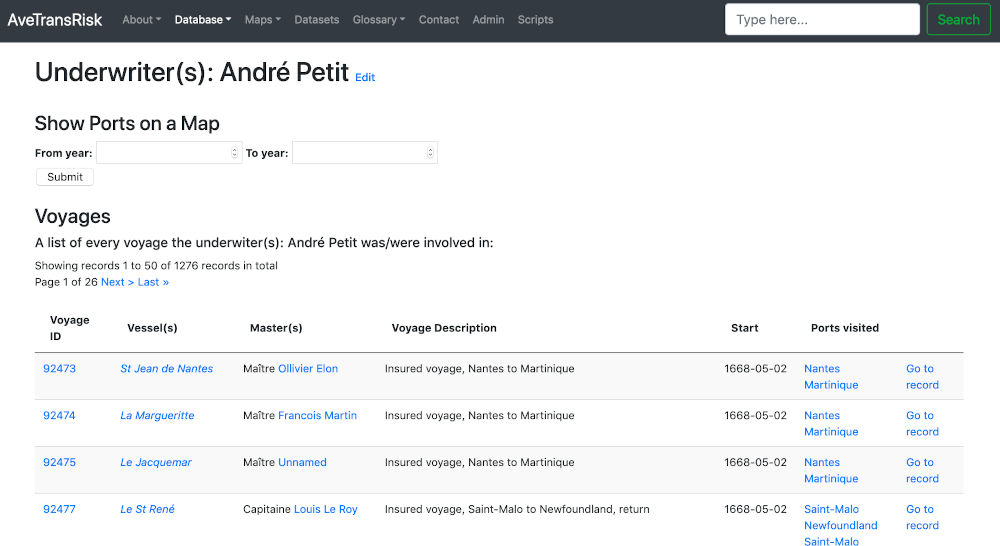
An Underwriter's portfolio - click for a larger version
Moreover, by entering "1668" into the "Show Ports on a Map" function at the top of the page, the user can view the entity’s portfolio on a map (whose functionality is discussed above).
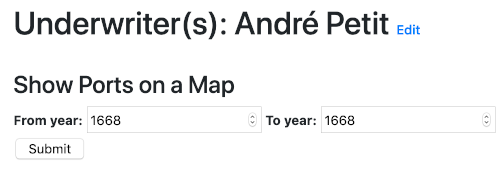
Setting the year - click for a larger version

The portfolio displayed on a map - click for a larger version
Finally, advanced users with specific queries can use the Advanced Search functionality, through selecting “Database” and then “Advanced Search” on the navigation bar. Users should construct their searches with the Query Builder, using the text and choice fields discussed in the section below.
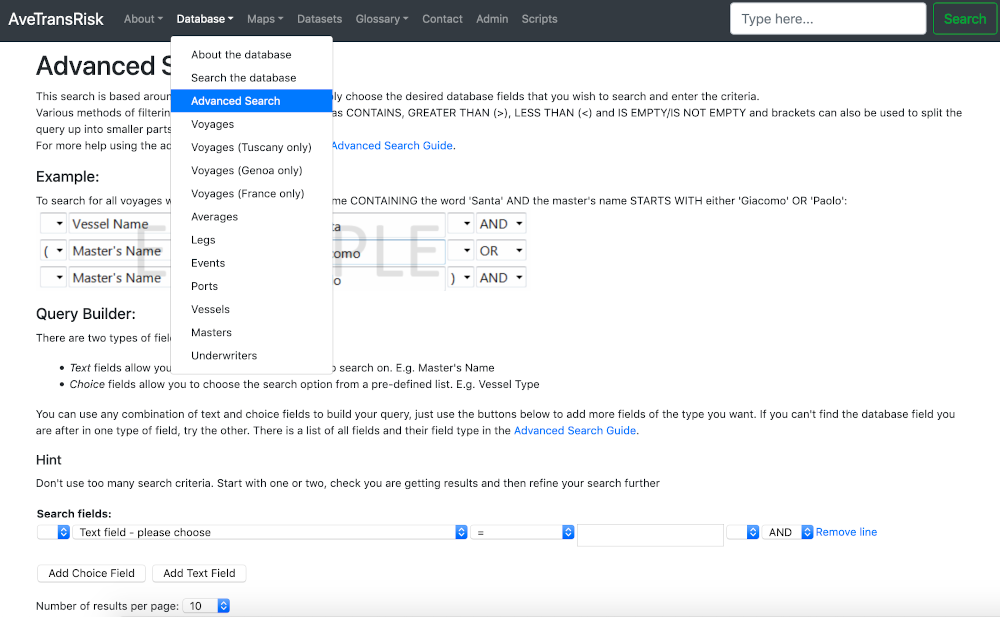
The 'Advanced Search' page - click for a larger version
The Chamber dataset
The foundation of the Chamber dataset (1668-72) is the insurance policy: every Voyage ID record corresponds to an insurance policy in the Chamber’s surviving insurance registers. Each Voyage ID record has information in the following three tabs.
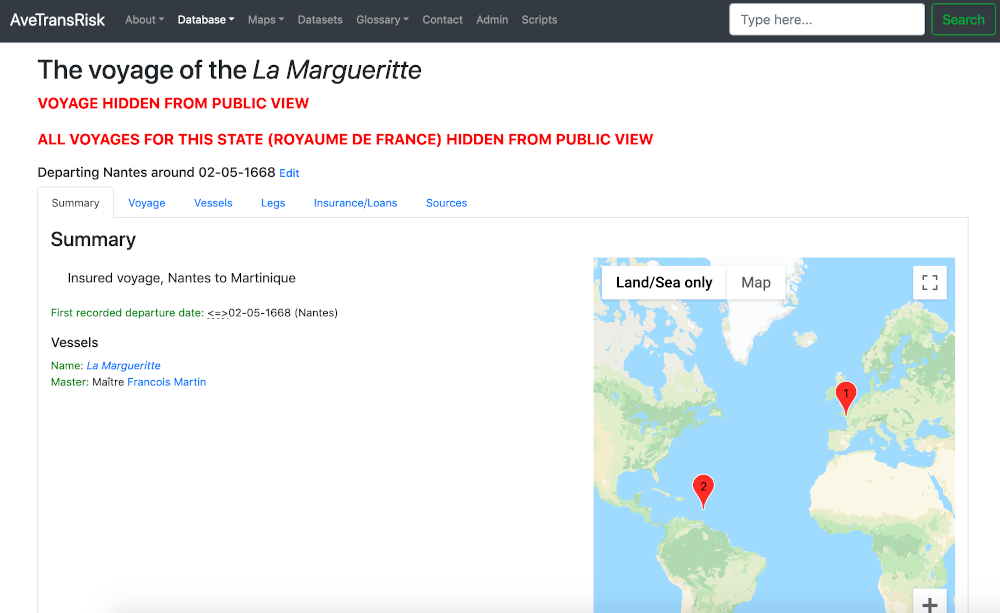
The individual record displayed on the 'Voyage' page - click for a larger version
Vessels – here, where given, the insured vessel and the shipmaster is named
Legs – here, the legs of the voyage are listed. The given arrival and departure dates correspond to the date of the insurance policy: these are not in any way indications of when the voyage may have taken place, nor whether the voyage took place as described. Indeed, it is in the very nature of insurance that the voyage described in this tab may have ended up being quite different in reality.
Insurance/Loans – this is where the key details on the insurance policy can be found. The entries are as follows:
Insurance/Loan ID et al.
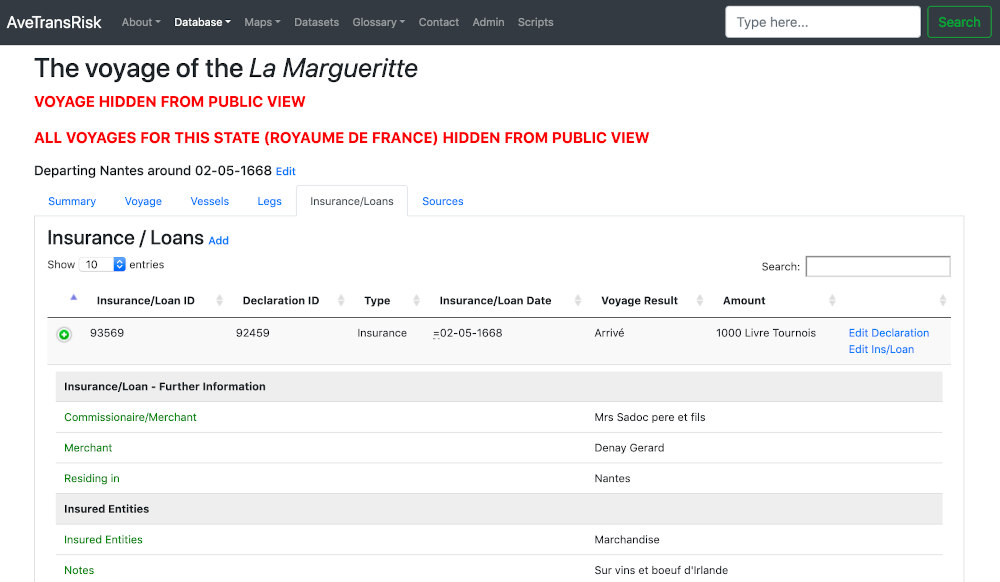
Insurance/Loan ID et al. - click for a larger version
“Type” – the type of contract; in this dataset, this will be either “Insurance” or “Reinsurance”
“Insurance/Loan date” – the date of the contract; where the precise date is unclear, due to damage to the registers, this is indicated
“Voyage Result” – the recorded outcome of the insured voyage. The possible voyage outcomes are as follows:
- Abandoned (abandoné)
- Arrived safely (arrivé)
- Average incurred (avarie)
- Confiscated (confisqué)
- Grounded (échoué)
- N/A (for those policies where no outcome is recorded)
- Lost (perdu)
- Wrecked (pery)
- Captured (pris)
“Amount” – the amount insured/reinsured in the policy
Insurance/Loan – Further Information
“CommissionaireMerchant” – the name of the merchant seeking insurance, or the name of the person acting on their behalf (known as a commissionaire)
“Merchant” – if a commissionaire is operating on behalf of a named merchant, it is here that the latter will be named
“Residing in” – if the locations of the commissionaire and/or merchant are known, they are given here
Insured Entities
This refers to the effects being insured. The subsequent “Notes” box is used to give further details where applicable. The possible insured effects are as follows:
- Hull (corps)
- Keel (quille)
- Cords (agrès)
- Tools (ustensiles)
- Food provisions (victuailles)
- Ship furniture, e.g. anchor, sail (apparaux)
- Sea loan/respondentia (argent donné à la grosse)
- Merchandise/cargo (marchandise/cargaison)
- Life (assurance sur la personne de [nom])
- Advances to the crew (avances faites aux matelots/à l’équipage)
Premium
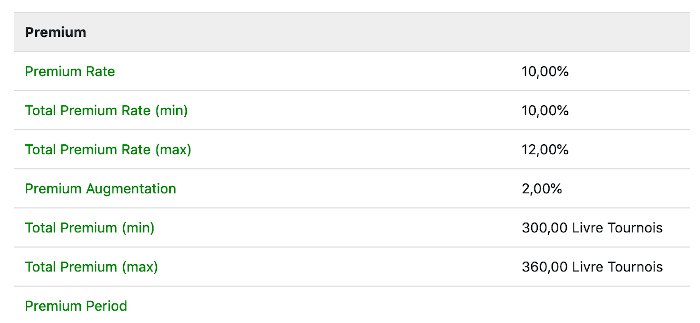
Premium - click for a larger version
This section comprises a series of entries. It is best explained through two examples.
Insurance policy A has a premium rate of 2 per cent per month for 6 months. Here, “Premium Rate” will read 2.00%; “Premium Period” will read 6; and “Total Premium Rate (min)” will read 12.00%.
Insurance policy B has a premium rate of 2 per cent – but, because it is signed in early 1672, with the threat of war, there is a war augmentation clause. This means that if war is declared during the insured voyage, the policyholder pays an agreed percentage of the premium on top of what they have already paid. In insurance policy B, this augmentation is 10 per cent. Here, “Premium Rate” will read 2.00%; “Premium Augmentation” will read 10.00%; “Total Premium Rate (min)” will read 2.00%; and “Total Premium Rate (max)” will read 12.00%. The “Total Premium (min)” and “Total Premium (max)” will follow accordingly, based on the amount underwritten.
Underwriters

Underwriters - click for a larger version
The Chamber was not a company: it was an institution for private underwriters. Multiple individuals, partnerships and companies could therefore underwrite the Chamber’s policies. All underwriters in the policy are listed here, alongside their “Share of premium (min)” (based on the “Total Premium Rate (min)”) and their “Share of premium (max)” (based, where applicable, on the “Total Premium Rate (max)”.
The Company dataset
The foundation of the Company dataset (1686-98) is the risk: every Voyage ID record corresponds to a particular combination of vessel, voyage and policyholder/debtor. This means that one risk might have one or several insurance policies or sea loans attached to it, and all will be included in the same Voyage ID. The Company’s alphabetical register does not give any premium rates, so these are not recorded in the database. Each Voyage ID record has information in the following three tabs.
Vessels – here, where given, the vessel and the shipmaster pertaining to the risk is named
Legs – here, the legs of the voyage are listed. The given arrival and departure dates correspond to the date of the first insurance policy/sea loan on the given risk: these are not in any way indications of when the voyage may have taken place, nor whether the voyage took place as described. Indeed, it is in the very nature of insurance that the voyage described in this tab may have ended up being quite different in reality.
Insurance/Loans – This is where the key details on the insurance policy can be found. The entries are as follows:Insurance/Loan ID et al.
"Type" – the type of contract; in this dataset, this will be either "Insurance" or "Sea loan"
"Insurance/Loan date" – the date of the contract; where the precise date is unclear, this is indicated
"Voyage Result" – the recorded outcome of the insured voyage. The possible voyage outcomes are as follows:
- Abandoned (abandoné)
- Arrived safely (arrivé)
- Average incurred (avarie)
- Confiscated (confisqué)
- Grounded (échoué)
- N/A (for those policies where no outcome is recorded)
- Lost (perdu)
- Wrecked (pery)
- Captured (pris)
"Amount" – the amount insured/loaned in the contract (where recorded)
Insurance/Loan – Further Information
"Commissionaire/Merchant" – the name of the merchant seeking insurance, or the name of the person acting on their behalf (known as a commissionaire)